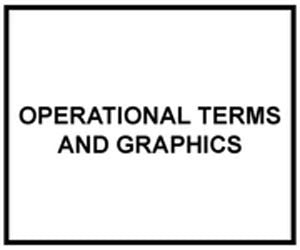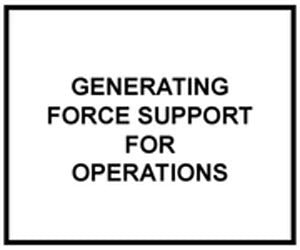
FM 1-02: OPERATIONAL TERMS AND GRAPHICS
Official US Army Field Manual in Acrobat PDF file format.
The terminology section of this manual is a compilation of doctrinally-accepted definitions that have been taken from approved manuals. One Army field manual is cited as the proponent or reference for each definition. (NOTE: As the US Army is in the process of changing the numbering system for its field manuals, the cited manual number reflects the number that was in effect at the time FM 1-02 was approved.) The proponent manual for all Marine Corps definitions in this publication is MCRP 5-12C, Marine Corps Supplement to the Department of Defense Dictionary of Military and Associated Terms.
Terminology entries in this manual fall into the following five categories:
• Definitions that are applicable to the US Army only. The definition is preceded by “(Army)” and followed by the proponent US Army field manual in parentheses:
situational understanding – (Army) The product of applying analysis and judgment to the common operational picture to determine the relationship among the factors of METT-TC. (FM 3-0)
• Definitions that are applicable to the US Marine Corps only. The definition is preceded by “(Marine Corps)”: situational awareness – (Marine Corps) Knowledge and understanding of the current situation which promotes timely, relevant, and accurate assessment of friendly, enemy, and other operations within the battlespace in order to facilitate decisionmaking. An informational perspective and skill that fosters an ability to determine quickly the context and relevance of events that are unfolding.
• Definitions that are applicable to both the US Army and US Marine Corps. The definition follows the term directly, and the proponent Army manual follows the definition:
actions on contact – A series of combat actions, often conducted simultaneously, taken upon contact with the enemy to develop the situation. (FM 3-90)
In some cases the Army and Marine Corps have agreed on a compromise definition for a particular term. This definition does not appear in either Service’s manuals, but will be incorporated into them when the appropriate manuals are revised. In such cases the definition is preceded by “(Army/Marine Corps)” and followed by the proponent Army manual:
route reconnaissance – (Army/Marine Corps) A directed effort to obtain detailed information of a specified route and all terrain from which the enemy could influence movement along that route. (FM 3-90)
• Joint and/or NATO terms whose definitions are applicable to the Army and Marine Corps as well. Joint and NATO definitions are reproduced exactly as they appear in JP 1-02 (12 April 2001, as amended through 05 June 2003) and AAP-6 (2003) respectively. The definition is preceded by one of four possible parenthetical notations (see below). “See FM XX” follows the definition, signifying that the indicated manual is the reference manual for Army-specific usage:
• (DOD): the term is a joint term. persistent agent – (DOD) A chemical agent that, when released, remains able to cause casualties for more than 24 hours to several days or
weeks. See FM 3-9.
• (NATO): the term is a NATO term. reference box – (NATO) The identification box placed in the margin of a map or chart which contains the series designation, sheet number and edition number in a readily identifiable form. See FM 3-25.26.
• (DOD, NATO): the term is both a joint and NATO term, and the joint and NATO definitions are virtually the same (with minor differences noted). combat power – (DOD, NATO) The total means of destructive and/or disruptive force which a military unit/formation can apply against the opponent at a given time. See FM 3-0. state of readiness – state 2 - armed – (DOD, NATO) The state of a demolition target in which the demolition charges are in place, the firing and priming circuits are installed and complete, and the charge is ready for immediate firing. [Note: the NATO definition does not include “and the charge is.”] See FM 5-250.
• (DOD)…. [Note: see AAP-6]: the term is both a joint and NATO term. The definitions are similar in meaning, but the wording is different. If the reader requires the exact NATO definition, he should consult AAP-6 (most current edition), NATO Glossary of Terms and Definitions. immediate decontamination – (DOD) Decontamination carried out by individuals immediately upon becoming contaminated. It is performed in an effort to minimize casualties, save lives, and limit the spread of contamination. [Note: See AAP-6.] See FM 3-5.
• Joint/NATO terms that are used by the Army/Marine Corps, but whose definitions are either inadequate for or not applicable to specific Army/Marine Corps usage. Both the joint and NATO definitions and the Service definitions are given. Where Army and Marine Corps definitions differ from each other, both are provided. The Army definition is followed by the proponent manual.
seize – (DOD) To employ combat forces to occupy physically and control a designated area. (Army) A tactical mission task that involves taking possession of a designated area using overwhelming force. (FM 3-90) (Marine Corps) To clear a designated area and obtain control of it.
If the term is a joint/NATO term, but no Army field manual is referenced, then this indicates that the Marine Corps has proponency for the term and definition: action phase - (DOD) In an amphibious operation, the period of time between the arrival of the landing forces of the amphibious force in the operational area and the accomplishment of their mission. See also amphibious force; amphibious operation; landing force; mission.
In addition, there are two further descriptors that may appear after a definition:
• “Also called”: If the term has an accepted abbreviation or acronym, the abbreviation or acronym appears bolded after the definition, preceded by “Also called”: passage point – A specifically designated place where the passing units will pass through the stationary unit. Also called PP. (FM 3-90)
• “See also”: If there are any related terms defined elsewhere in the manual, they are crossreferenced at the end of the definition as bolded terms preceded by “See also”: hostile criteria – Description of conditions under which an aircraft or a vehicle may be identified as hostile for engagement purposes. See also hostile acts; rules of engagement. (FM 27-10)
The symbology section is broken down into chapters dealing with unit symbols, equipment symbols, graphic control measures, installation symbols, and stability operations and support operations symbols. Each of these chapters provides detailed requirements for composing and constructing its associated symbols and control measures. While the manual does not include every possible symbol for every possible context, the rules for building a specific set of military symbols allow enough flexibility for users to create any symbol to meet their operational needs.
This manual contains a compilation of graphic control measures. This revision includes information on building symbols and using graphics omitted in the 1997 version that appeared in earlier versions of military symbology manuals. It includes a link between terms and symbols with the cross-referenced terms, including the proponent manual that provides the description for the usage of the graphic control measures. All graphic control measures in this manual are linked to doctrine.
File download size: 18 MB



